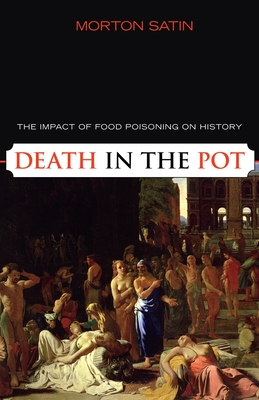You are here
Back to topDeath in the Pot: The Impact of Food Poisoning on History (Hardcover)
$26.99
Usually Ships in 1-5 Days
Description
Did food poisoning play a role in the Salem witch trials, leading to the hanging of nineteen men and women? Which poison recently laced the food of Russian ex-KGB agent Viktor Litvinenko, and how did it kill him? In Death in the Pot, internationally renowned food expert Morton Satin documents several culinary mishaps and misdeeds in an engrossing narrative that spans the ancient world to the present day.
Historic events both tragic and bizarre have resulted from adulterated food. In the fifth century BCE, the great plague of Athens, probably caused by contaminated cereals, led to the defeat of the Athenians in the Peloponnesian War. In the prescientific Middle Ages, illnesses resulting from contaminated food were often attributed to the wrath of God or malevolent spirits. Heavily infectious ergot induced a spasmodic muscle condition, which the Church named "St. Anthony’s Fire" and interpreted as retribution by God on heretics. Similarly, in seventeenth-century America the hallucinogenic symptoms of moldy grain were thought by Puritans to be signs of witchcraft. Even the madness of King George III, which played a role in the American Revolution, may have been induced by accidental arsenic poisoning.
In the twentieth century, Satin recounts the efforts of modern industrial societies to make food safer; in some cases these efforts were heroic. For example, in the early days of the Food and Drug Administration a "Poison Squad" was formed, consisting of young scientists who willingly acted as guinea pigs to test the toxic effects of chemical additives. Today, the government has focused on the hazards of food bioterrorism. Satin concludes by describing measures taken to protect the public from intentional and unintentional poisoning, as well as recounting recent poisoning incidents.
Both a fascinating glimpse into history from a unique angle and an authoritative reference work on food safety, Death in the Pot offers entertaining and informative reading for laypersons as well as experts in food technology and public health.
About the Author
Morton Satin is currently the director of technical and regulatory affairs at the Salt Institute. He recently retired as the director of the United Nations Food and Agriculture Organization’s Global Agribusiness Program. A molecular biologist, he is the author of Death in the Pot: The Impact of Food Poisoning on History and Coffee Talk: The Stimulating Story of the World's Most Popular Brew.
Praise For…
"In this unexpectedly timely account, Satin makes a case for how food poisoning has affected human events over time....[H]is speculations are fascinating....[M]any of the details are quite arresting."
PUBLISHERS WEEKLY
"Satin provides a fascinating account of how food and wine toxicity changed the course of history. This is a spellbinding read for anyone interested in food, wine, science, or history."
CHRISTINE M. BRUHN, PhD
Director, Center for Consumer Research
Department of Food Science and Technology
University of California, Davis
"Death in the Pot delivers equal portions of wit and wisdom in an entertaining and informative cautionary history. Morton Satin’s examples span pre-historic times to the latest headlines and remind us of our intimate connection with the food that we eat and its potential to deliver our own destruction. Food poisoning is a topic that could easily become grim, but Death in the Pot is inoculated with enough humor to make it all very readable."
CHRIS FINDLAY, PhD
Councilor of the Institute of Food Technologists
Consultant to the United Nations Food and Agriculture Organization
